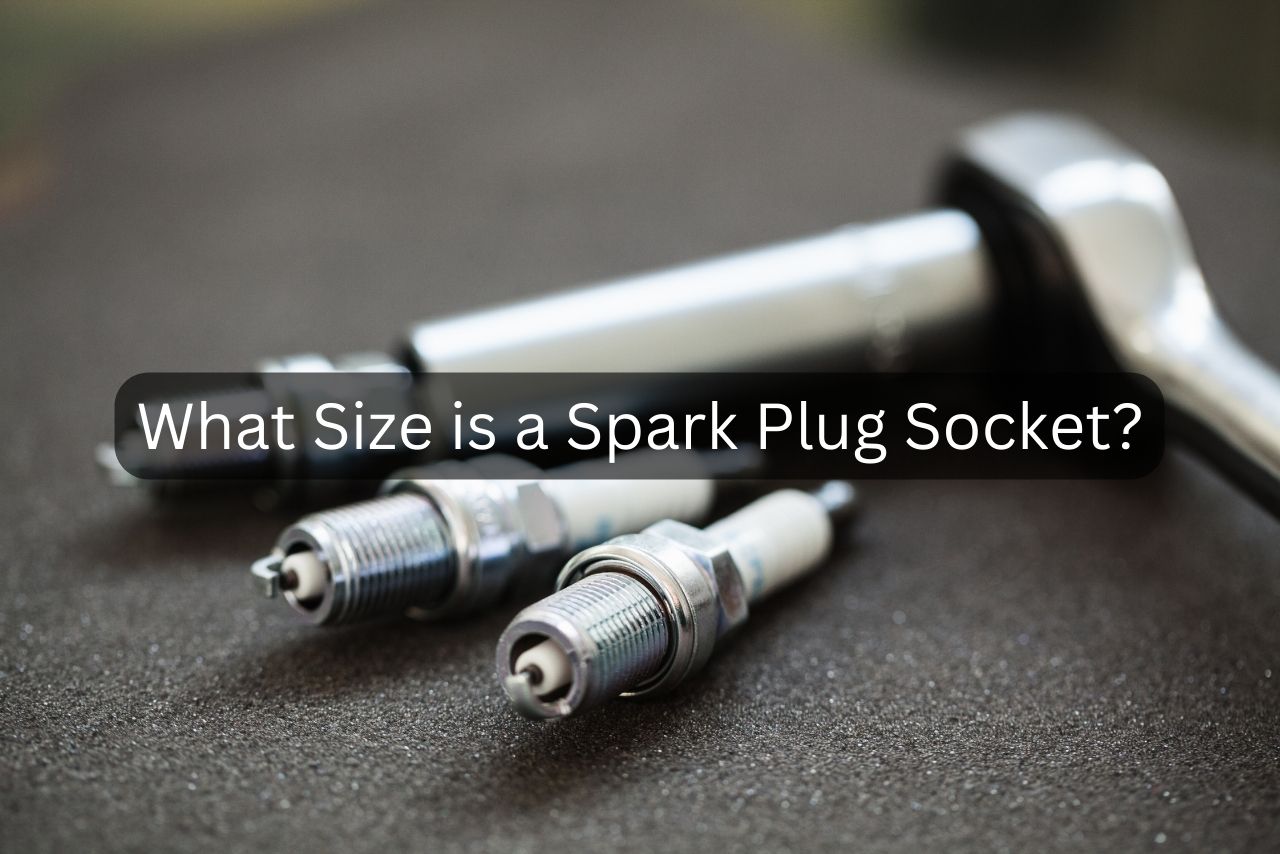Spark plugs are an essential component of any combustion engine, and knowing the correct size of spark plug socket, spanner, or wrench is crucial for maintenance. So, What Size is a Spark Plug Socket, Spanner Or Wrench?
The standard spark plug socket sizes are 5/8″ or 13/16″, with some older cars opting for 11/16″. In contrast, modern vehicles typically require either a 14mm or a 16mm socket. European engines may have bi-hex 14mm spark plug sizes, while the less common options include bi-hex or 12mm hex sizes.
However, it’s not just about the size; accessing and changing spark plugs can vary greatly depending on the vehicle. Some models allow for quick replacements in just minutes.
On the other hand, certain vehicles may necessitate removing additional components such as the upper intake manifold to reach the spark plugs effectively.
It’s important to be aware of these differences to ensure a smooth and efficient maintenance process.
Table of contents
What is a Spark Plug Socket?
A spark plug socket is a type of socket that is specifically designed to remove and replace spark plugs. It is typically deeper than a standard socket, which helps to protect the spark plug from damage.
Spark plug sockets often have a rubber insert that helps to grip the spark plug and prevent it from slipping. Some spark plug sockets also have a magnet that helps to hold the spark plug in place while it is being removed or installed.
Spark plug sockets are available in a variety of sizes, to accommodate the different thread sizes of spark plugs. The most common spark plug socket sizes are 5/8 inch (16mm), 14mm, and 18mm.
It is important to use the correct size spark plug socket for your vehicle. Using the wrong size socket can damage the spark plug or the threads in the engine block.
Here are some of the benefits of using a spark plug socket:
- It fits snugly on the spark plug, which helps to prevent it from slipping and being damaged.
- The rubber insert helps to grip the spark plug and prevent it from slipping.
- The magnet helps to hold the spark plug in place while it is being removed or installed.
- It is specifically designed for spark plugs, so it is more likely to fit snugly and prevent damage.
Standard Spark Plug Socket Sizes:

| Spark Plug Socket Size | Thread Size |
|---|---|
| 5/8 inch (16mm) | 14mm |
| 14mm | 14mm |
| 18mm | 18mm |
| 3/4 inch | 18mm |
| 9/16 inch | 12mm |
Access to spark plugs can vary significantly among vehicles. Here are some examples:
- Quick and Easy Access:
- In some vehicles, changing the spark plugs is a breeze and can be done in minutes.
- Additional Component Removal Required:
- However, other vehicles may pose more challenges as they require the removal of additional components such as the upper intake manifold.
Sizes for Older Cars:
When it comes to older cars, the standard spark plug socket sizes may vary slightly. Here are some common sizes you might come across:
It’s important to note that these sizes are not as widely used in modern cars, but they can still be found in certain models from previous decades.
To give you a better understanding of the evolution of spark plug socket sizes over time, here’s a comparison with more recent measurements:
- Modern cars typically use larger socket sizes:
- 14mm: This is a commonly used size in many modern vehicles.
- 16mm: Some newer car models may utilize this larger size.
- European engines may have bi-hex 14mm spark plug sizes:
- Bi-hex refers to a type of socket with twelve points instead of six.
- Uncommon hexagonal (hex) sizes:
- Bi-hex or 12mm hex: While less common, some specialized engines might require these smaller sized sockets.

Remember that access to spark plugs can vary greatly depending on the vehicle make and model.
While some older cars allow for quick and easy changes within minutes, others may necessitate removing additional components such as the upper intake manifold.
Sizes for Modern Cars:
When it comes to modern cars, the spark plug socket sizes can vary. Here are some common sizes you may come across:
It’s important to note that European engines often have bi-hex 14mm spark plug sizes.
Bi-hex refers to a special type of socket with twelve sides instead of six. These sockets provide better grip and reduce the risk of damaging the spark plug during installation or removal.
While 12mm hex sizes are uncommon, they might be encountered in certain cases.
Remember that when changing spark plugs, access can vary greatly among different vehicle models. While some vehicles allow for quick and easy replacement within minutes, others may require additional steps such as removing components like the upper intake manifold.
Here’s a breakdown of the standard and alternate socket sizes mentioned earlier:
| Standard Socket Size | Alternate Socket Size |
|---|---|
| 5/8″ | – |
| 13/16″ | – |
| 11/16″ | – |
Please keep in mind that these measurements correspond to imperial units (inches). It’s essential to select the correct size based on your specific vehicle’s requirements.
Bi-hex Sizes in European Engines:
Here are some key points regarding bi-hex sizes:
Overall, if you own a vehicle powered by a European engine and need to replace your spark plugs, make sure you have access to an appropriate-sized 14mm bi-hex socket as it will ensure proper fitting and minimize any potential damage during maintenance tasks related to your vehicle’s ignition system.
Uncommon Bi-hex or 12mm Hex Sizes:
In addition to the standard spark plug socket sizes, there are some uncommon options that you may come across when working with certain engines. These include the bi-hex 14mm and the 12mm hex sizes.
Here’s what you need to know about these less common spark plug sizes:
- Bi-hex 14mm Spark Plug Size:
- European engines sometimes utilize a bi-hex (also known as double hex) design for their spark plugs.
- The bi-hex size refers to a spark plug socket that has two sets of hexagonal openings: one on each end.
- The specific size required for this type of spark plug is typically 14mm.
- 12mm Hex Spark Plug Size:
- While not as prevalent as other sizes, some vehicles may have spark plugs with a 12mm hex head.
- This smaller hex size requires a corresponding socket specifically designed for it.
It’s important to note that these uncommon spark plug sizes are not encountered frequently in modern cars but can be found in older models or specialized engine types.
When working on your vehicle, always consult your vehicle owner’s manual or refer to reliable sources such as manufacturer recommendations or online forums dedicated to car enthusiasts.
Properly identifying the correct socket size will ensure smooth removal and installation of your spark plugs without causing damage.
Remember, access to spark plugs can vary significantly among different vehicles. While some may offer easy and quick replacement procedures, others might require additional steps such as removing components like the upper intake manifold before gaining access to the sparks plugs themselves.
Variations in Access to Spark Plugs:
When it comes to accessing spark plugs, different vehicles can vary significantly. Some cars make it easy for you to change the spark plugs in a matter of minutes, while others may require the removal of additional components like the upper intake manifold.
Here are some variations you might encounter:
To help simplify things during maintenance tasks like replacing your spark plugs, familiarize yourself with your vehicle’s specifications and consult its manual if needed.
What Are the 3 Sizes of Spark Plug Sockets?
The 3 most common spark plug socket sizes are:
There are also other sizes available, such as 3/4 inch and 9/16 inch, but these are less common.
It is important to use the correct size spark plug socket for your vehicle. Using the wrong size socket can damage the spark plug or the threads in the engine block.
Here is a table of the most common spark plug socket sizes and their corresponding thread sizes:
| Socket Size | Thread Size |
|---|---|
| 5/8 inch (16mm) | 14mm |
| 14mm | 14mm |
| 18mm | 18mm |
| 3/4 inch | 18mm |
| 9/16 inch | 12mm |
Can I use a normal socket for spark plugs?
You can use a normal socket for spark plugs, but it is not recommended. Spark plug sockets are designed specifically for spark plugs, and they have a few features that make them better suited for the job.
If you do not have a spark plug socket, you can use a deep socket of the correct size. However, be sure to use caution and be careful not to damage the spark plug.
Here are some of the risks of using a normal socket for spark plugs:
Do I Need A Special Socket Set To Remove Spark Plugs, Or Will Any Socket Set Work?
To remove spark plugs, you generally need a special type of socket called a spark plug socket. While it’s possible to use a regular socket set, a spark plug socket is specifically designed to fit the unique shape of a spark plug and has a rubber insert or magnet to securely hold the spark plug in place.
Using a regular socket set without the proper spark plug socket can be risky. The spark plug could become stuck inside the socket, making it difficult to remove, and there’s a chance of damaging the spark plug, threads, or the socket itself.
Moreover, the rubber insert or magnet in a spark plug socket helps prevent the spark plug from falling out during removal or installation.
Therefore, it’s highly recommended to use a spark plug socket for the task. They are relatively inexpensive and can be found at most auto parts stores.
Make sure to get the correct size spark plug socket that matches the size of your spark plugs, as different vehicles may require different sizes.
What Size Is A 14mm Spark Plug Socket?
A 14mm spark plug socket has a size of 5/16 inches. This is because 14mm is equal to 0.55118 inches. So, a 14mm spark plug socket will fit snugly on a spark plug that has a thread size of 14mm.
What Size Spark Plug Socket For F150 5.4?
The spark plug socket size for a Ford F-150 5.4L engine is 9/16 inch. This is because the spark plugs on this engine have a thread size of 12mm, and a 9/16 inch socket is the correct size to fit these spark plugs.
Conclusion and final thoughts 💭
Spark plug sockets, spanners, and wrenches come in various sizes to accommodate different types of spark plugs.
The standard socket sizes for most vehicles are 5/8″ or 13/16″, with some older cars using 11/16″. However, modern cars typically require either a 14mm or 16mm socket size.
It’s important to note that European engines may have bi-hex 14mm spark plug sizes, while bi-hex or 12mm hex sizes are less common.
When it comes to accessing and changing spark plugs, the process can vary greatly depending on the vehicle.
While some vehicles allow for quick and easy changes that take just minutes, others may require additional steps such as removing the upper intake manifold or other components.
Latest Posts:
- Can WD-40 Remove Scratches on Cars? (Hint: Yes, but…)
- Can You Use a Drill to Polish Your Car? (We Tried it Out!)
- Should You Cover Car Scratches With Stickers? (REVEALED!)
- Buick Service Stabilitrak: (Causes & 100% Guaranteed Fix!)
- Common Holden Trax Problems (Causes & 100% Proven Fixes!)
- Jeep Commander Transmission Over Temp: (Guaranteed Fix!)











Leave a Reply